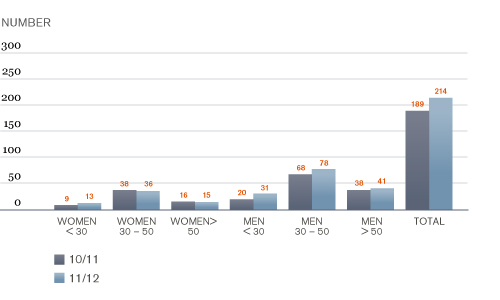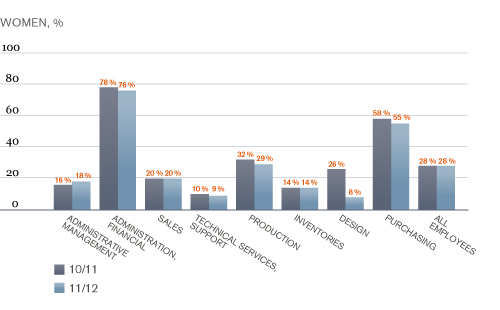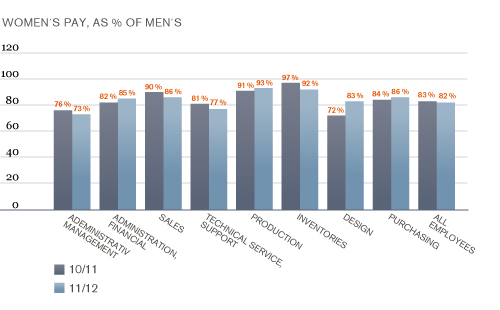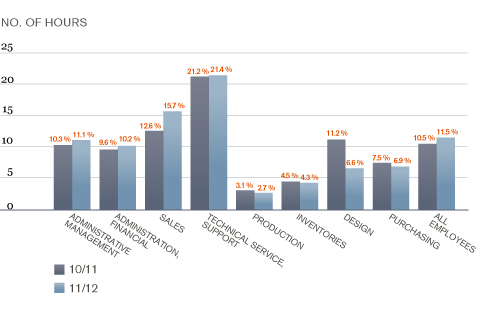Employees
The average number of employees in the Addtech Group in 2011/2012 was 1,612, of whom 448 were women and 1,164 were men.
During the year, we conducted an employee survey covering all employees in the Group. This was the first of its kind within the Group, since each subsidiary before has been responsible for conducting employee surveys. The aim of the survey was to identify areas in which the Group and subsidiaries currently perform well as an employer and areas in which we can improve. From a Group perspective, the survey will give us the possibility to offer the subsidiaries support where there are common needs, and also to spread knowledge and ideas from successful subsidiaries further in the Group.
The survey shows that the Group´s employees enjoy working at their workplaces. The survey also shows that the employees have a similar view of the subsidiaries as employers, irrespective of in which country they are working in.
We encourage each MD within in each subsidiary to develop an action plan that is based on the subsidiary's individual result. The result of this year´s employee survey will also form the foundation of long-term, strategic staff development work in the Group. The Group´s ambition is to conduct an employee survey annually.
Employee turnover

During the year, employee turnover was 13 % (13 %). The table Employee Turnover provides a more detailed picture of the Group´s employee turnover, by gender and age. Addtech is at heart a Nordic enterprise; around 90 % of the Group´s employees work in one of the Nordic countries.
Gender distribution

Historically, the technology trading sector has been male dominated. This is also reflected by the percentage of male and female applications to institutes of technology in Sweden. Our ambition is, by being attractive employers, continuously to increase the percentage of women in the Group. The percentage of women and men, respectively, in the Group shall at least reflect the general gender distribution in our industry, as well as the percentage of graduates from institutes of technology. Key figures for the gender breakdown men and women at Addtech are shown in the table above.
Pay differences

Differences in pay for men and women in the Group vary in different professions. Our mapping shows an imbalance between male and female wages, and a project with the ambition to correct the imbalance has therefor been initiated. Addtech strives to offer all employees in the Group, regardless of gender, equal pay for equal work.
Employees

Permanent employees constitute a large majority of the Group´s workforce. Contract employees are mostly used to replace existing employees in the case of illness or other absence. The diagram above shows a breakdown of employees by permanent and contract employment.
Direct dialogue with the Group´s employees takes place at local level at each company in the Group, for example in connection with annual development review. Addtech´s development and competitiveness are strongly linked to the enhancement of expertise and the wellbeing of its employees. The Group´s companies strive to be attractive employers that offer our employees viable opportunities for personal development.
One ambition within the Group is that all employees should take part in a personal development review with their immediate manager every year. An important part of the development review is to identify ways of improving the expertise and wellbeing of the employee. Another is to increase contentment and job satisfaction at the workplace. In 2011/2012, formal development reviews were held with 60 % (62 %) of Addtech´s employees. Unfortunately, this represents a decline from the preceding year and falls well short of our long-term ambition. Part of the explanation lies in the acquisition of a large number of new companies and employees by the Group during the year.
Over the coming year, Addtech will continue to review the routines and tools that are available to the Group´s companies, in order to increase the percentage of development reviews conducted.
Hours of training per employee

To develop the expertise of its employees is to develop the Addtech business. To this end, the Group runs its own Business School, among other activities. The table above shows the number of training days per employee and per employee category during the year.
Health and safety

As a technology trading group, we cannot ignore the fact that our employees could be involved in bribes - especially in connection with purchases in countries where corruption is generally widespread. The trend in corruption in various countries where Addtech operates is monitored constantly, for example via the Transparency International website (www.transparency.org). Business ethics has always been high on the Group´s agenda and constitute an issue that is continuously addressed in the Group´s own Business School. The Group has zero tolerance towards corruption, and the fact that no cases of corruption occurred during the year (0) is thus in line with our expectations.
